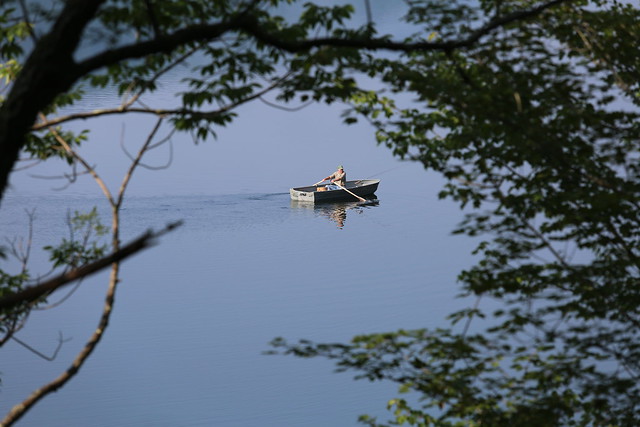FOR IMMEDIATE RELEASE 15-97 December 1, 2015 Contact: deppressoffice@dep.nyc.gov, (845) 334-7868 Department of Environmental Protection Announces Largest Year-Over-Year Increase for Recreational Boating Program in the CatskillsSpurred by rental program, paddling and sailing led to more than 1,400 visits in tfhe CatskillsPhotos can be viewed on DEP’s Flickr PageThe New York City Department of Environmental Protection (DEP) today announced that its recreational boating program in the Catskills led to 1,463 visits this year, an all-time high for the program that marks the largest year-over-year increase in participation since it began in 2012. The participation in 2015 marks a nearly 24 percent increase over the previous year, during which the program attracted 1,182 visits. The increase was mostly driven by the success of the rental program, which allows visitors to rent a kayak or canoe from one of six businesses in the Catskills that store pre-cleaned rental boats alongside the reservoirs. Local businesses rented their boats a total of 683 times in 2015, representing a 92 percent increase from the 355 rentals last year. The rental program, administered in partnership with the Catskill Watershed Corporation (CWC), began in 2013 to provide easier boating access for visitors to the Catskills. It has also helped support local businesses by providing a new source of revenue. The recreational boating program at Cannonsville, Neversink, Pepacton and Schoharie reservoirs complements the traditional use of metal rowboats for fishing, which has been permitted for decades on all New York City reservoirs. “The recreational boating program continues to offer a unique outdoor experience for those who want to explore the Catskills and enjoy its scenic beauty,” DEP Commissioner Emily Lloyd said. “The steady growth in participation, especially for the rental program, shows that our efforts to promote watershed recreation are working. DEP will continue to collaborate with tourism agencies, nonprofit groups and others to keep a spotlight on the Catskills and encourage more visitors to enjoy its natural resources.” “Our aim in supporting recreational boating has been to boost the local economy,” said Alan Rosa, Executive Director of the Catskill Watershed Corporation. “We’re glad to see boating on the rise, and vendors and area businesses benefitting from this program.” DEP issued 780 tags to boaters in 2015, including 511 kayaks, 226 canoes, 40 rowboats, two sailboats and one scull. Including boat rentals, Pepacton Reservoir attracted 840 boating visits, the most of any reservoir, followed by 359 at Neversink, 180 at Schoharie, and 84 at Cannonsville. Roughly 19 percent of the recreational boating tags issued by DEP went to residents of the five watershed counties, including Delaware, Greene, Schoharie, Sullivan, and Ulster. About 11 percent of the tags were issued to residents of New York City or Long Island. Visitors from five states also received tags, including Connecticut, Maryland, Pennsylvania, New Jersey and Vermont.
DEP Recreational Boating Program Visits
Note: 2009-2011 include a pilot program at Cannonsville only
For the third year, rental boats were available from 10 launch sites alongside the four reservoirs. Six businesses participated in the rental program and 683 kayaks and canoes were rented to visitors. Local businesses this year reported that more visitors were adding a boat rental on the reservoirs as part of their stay at local campsites, lodges or other overnight facilities, which had included boating on the reservoirs as part of their marketing. The rental program is administered with significant help from the CWC, which funded the acquisition of 30 storage racks for the rental boats beginning in 2013. The CWC also administers the process to vet and approve businesses that applied to participate in the rental program. 2015 marked the fourth year of the expanded recreational boating program, which followed a three-year pilot that began in 2009 at Cannonsville Reservoir. Prior to 2009, DEP only issued tags for metal rowboats that were used and stored at the reservoirs for the purpose of fishing. That original program remains popular, with more than 12,000 tags currently issued to anglers who have rowboats at the reservoirs. Regular water-quality monitoring at each of these reservoirs has shown no impact from recreational boating. DEP’s invasive species experts have surveyed every boat launch site and found no sign of aquatic plants or animals that can harm drinking water quality. Every boat that is used on the reservoirs is required to be inspected and steam cleaned to avoid the spread of invasive species. DEP manages New York City’s water supply, providing more than one billion gallons of high quality water each day to more than 9 million New Yorkers. This includes more than 70 upstate communities and institutions in Ulster, Orange, Putnam and Westchester counties who consume an average of 110 million total gallons of drinking water daily from New York City’s water supply system. This water comes from the Catskill, Delaware, and Croton watersheds that extend more than 125 miles from the City, and the system comprises 19 reservoirs, three controlled lakes, and numerous tunnels and aqueducts. DEP has nearly 6,000 employees, including almost 1,000 scientists, engineers, surveyors, watershed maintainers and other professionals in the upstate watershed. In addition to its $70 million payroll and $157 million in annual taxes paid in upstate counties, DEP has invested more than $1.7 billion in watershed protection programs—including partnership organizations such as the Catskill Watershed Corporation and the Watershed Agricultural Council—that support sustainable farming practices, environmentally sensitive economic development, and local economic opportunity. In addition, DEP has a robust capital program with nearly $14 billion in investments planned over the next 10 years that will create up to 3,000 construction-related jobs per year. For more information, visit nyc.gov/dep, like us on Facebook, or follow us on Twitter. | ||

